- info@wildlife-removal.com
Call us for help in your town
Wildlife Removal Education
How to Trap Skunk, Trapping Tips Bait
Need skunk removal in your hometown? We service over 500 USA locations! Click here to hire us in your town and check prices - updated for year 2020.
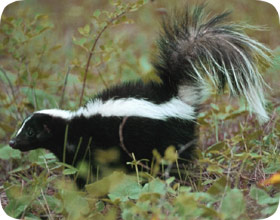 Skunks aren't too hard to trap. Below is a list of tips to trap skunks effectively.
Skunks aren't too hard to trap. Below is a list of tips to trap skunks effectively.
- Use a large cage trap, raccoon sized.
- Set the trap in areas you have seen skunks.
- Make sure the trap is firm on the ground.
- Bait the trap with cat food or marshmallows.
- Put a cover over the top of the trap.
And don't forget: if you have trouble and want to hire a pro like me, someone with experience,
click on this map of Professional Wildlife Removal Companies, and you'll find an expert in your town or city. Skunk trapping
carries a special consideration, namely that this animal can spray once caught in a trap! Transferring or dealing the the animal can be a dangerous challenge. If you want
to try to do it yourself, read my how to get rid of skunks page - but I'll let you know now that I recommend trapping
as the best, and most effective method!
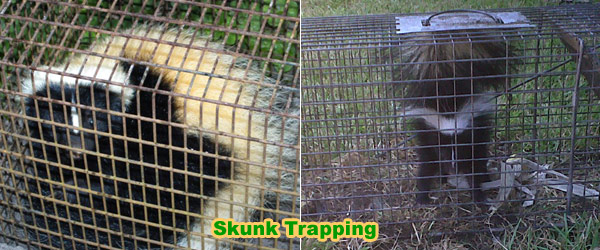
What type of trap catches skunks? - A live cage trap, raccoon sized, is best. At least 30 inches long, 12 inches high, ten inches wide. There are many fine
manufacturers of traps this size. I've tended to go with the Havahart 1079. But other models will do too, I'm sure. Some people use solid-wall traps to
catch skunks, and those are a really great option. The skunk can't see you out of such a trap, and more importantly, it can't spray you. I've never had a
skunk spray inside one of these traps. But they may be trickier for you to buy. Even Home Depot sells large cage traps, but if you want a solid trap, you
have to find one online and buy it.
What type of bait catches skunks? - Many people want to know what food catches skunks. It's kind of a trick question. The most effective single bait for skunks
is usually a meat-based bait, such as wet cat food. Dry cat food works too. But the problem is that these baits might actually catch stray cats! Or people's pet cat. So
it might actually be best for you to use marshmallows, which don't attract cats. If you're feeling confident that cats won't be a problem, then go ahead and use meat
bait, such as cat food. Read more about What is the best bait to trap a skunk?
Where should I set the skunk trap? - Set it wherever you've seen the skunks. Most commonly, people seem to have problems with skunks going under decks, sheds, porches, or
the like. You can set traps at the edge of the porch then. Or, you can install an exclusion barrier around the perimeter of the porch, but leave one small gap open, and
set the trap with the open door facing the gap. That way, whenever the skunk tries to come out, it'll have no choice but to enter the trap. If you've just got skunks on your
property, stealing pet food or harassing your pets or digging lots of little holes all over the lawn (this process is called yard grubbing), then you can set the trap
pretty much anywhere, so long as the animal can smell the bait.
Okay, after I've trapped it, how do I prevent it from spraying? - Aha! Not a problem. Just approach the trapped skunk while holding a cloth, like an old towel, blanket, or bed sheet
out wide. Don't let the skunk see you. Gently and slowly approach it, and drape the cloth over the trap. If the skunk can't see, it can't spray. It won't spray if it doesn't
know where to spray. Once the cloth is over the cage, it'll calm down. That said, you can still watch the skunk and understand its behavior, and the three signs that it's
going to spray.
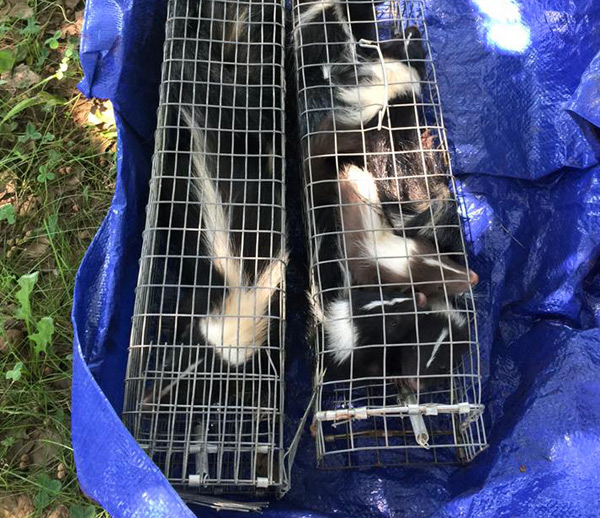
Sign One: The skunk raises its tail. If it does this, it's agitated, and giving you a warning of what it can do. So just back off, and wait for it to calm down and lower the tail.
Sign Two: If the skunk backs up away from you, with tail raised and fanned, and it starts stomping at the ground with its little front feet, then things are serious. Again,
back off and wait for it to chill out before you approach again.
Sign Three: If the skunk whip their rear end around at you with their rectum facing you, and they look back over their shoulder at you, tail high and flared, run! Run as fast as you
can, because it's about to let loose with its terrible smelly spray! Again, you can wait out such an agitated state, and approach later.
I should also point out that adult skunks have much better control (like adult humans! Baby skunks are much more likely to misfire, prematurely spray, etc. So keep that in mind. A young
skunk is far riskier than an adult skunk, and should be treated accordingly.
What should I do with the animal after I've caught it? - With the cloth still draped over the cage, put the skunk in the trunk of your car or bed of your truck, and put down a rag or tarp to block the dirt,
and drive the animal at least five miles away to an approved relocation point, if it's legal to do so in your state. Then open the door and let it out! Some states don't allow skunk relocation, so I have
this how to kill a skunk page, but really, I do think you can relocate with no problems.
Also read:
Do mothballs and ammonia help repel skunks?
What should I do with a skunk after I catch it?
Can Skunks Climb Fences?
Should You Remove Skunks Yourself Or Hire A Professional?
Is It Legal To Trap A Skunk?
Can Skunks Climb Trees or Fences?
Will A Skunk Have a Nest of Babies Under a Shed or Porch?
How Can Skunks Damage Under Your House?
Best Ways To Remove Skunks From Under Your Shed or Porch
Why Skunks Spray
For more information on skunk biology and behavior, and for a recipe to remove skunk spray odor, go to my skunk removal information page.
Where to Relocate A Trapped Skunk
So you have learned that trapping is your best bet for getting rid of that stubborn skunk on your residence and you have finally decided to give it a try.
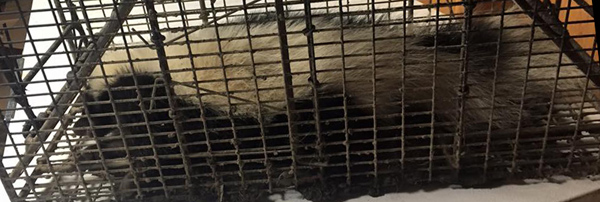
While trapping is one of the best ways to get rid of your resident skunks, you must be prepared for the eventuality of what to do with it once caught in your trap. In fact, it is important that you make this decision before setting the trap, so that the animal is not inhumanely kept in your cage for an extended period while you try to figure out your next steps.
A trapped skunk may either be killed or relocated to an appropriate location at least 10 miles from the point of capture. Ideally, relocation of nuisance animals is a humane way to deal with them, and in order to preserve the humane nature of this exercise, it must be carried out with attention to detail.
The following are some attributes of an ideal location for your trapped skunk:
- It should be at least 10 miles away from your property so that it cannot find its way back
- It should be a woody or forest area, where food supply and other survival requirements would be readily available for the animal.
- It should be preferably close to a body of water
- It should be a potentially great place to source skunk foods like insects like crickets, grasshoppers, beetles, cutworms and various insect larvae. Also fruits, berries, grasses, and roots.
Note: Never release a skunk that you suspect of being rabid, that is showing signs of aggression, very nervous activity or salivation. Look out for signs like circling movements, disorientation, limb weakness, unusual boldness or unusual tameness. Take this skunk to your local animal department for rabies testing, and possible elimination.
Also note that skunk control activities are often guided by state or county-specific regulations, so you would do well to check up on what is allowed in your locality before deciding on any of these options.
Tips On Trapping A Skunk
Despite the pest controlling benefits of having skunks around, most homeowners prefer to have a skunk-free environment because of their notorious odor and their tendency to dig beneath foundations. The best way to achieve this is to exclude the animals by closing or sealing all possible entry points into spaces under buildings and other structures.
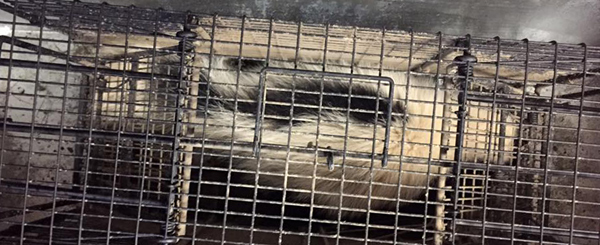
If a skunk has already gained entrance and has found itself a den in your yard, then what you need to do is to trap and remove it. Live skunk trapping is one of the most effective ways to control skunk although the challenge for most people is in not wanting to get sprayed. Skunks are known to release an obnoxious spray when they feel threatened. It is however very possible to trap and remove a skunk without getting sprayed.
Setting a Trap
- Buy a medium to large steel cage kind of trap. They are spring-loaded to shut the door on the animal as soon as it gets lured inside. Raccoon traps are great for catching skunks too.
- Use peanut butter, fish, or some other strong-smelling food as a bait inside the trap.
- Position the trap along the skunk’s path or in front of its den; this may be in tree hollows, hollow logs, brush piles, porches, underneath structures, or burrows.
- Set the trap at dusk as the skunk is nocturnal. You may want to remove it at daytime so you don’t catch other, unwanted critters.
- Check the trap frequently for early detection of a catch. This way, the animal does not suffer for so long.
Retrieve Successful Trap and Avoid Getting Sprayed
- Get a large, old towel or sheet and hold it in front of you as move towards the trap. Skunks don’t usually spray if they cannot see their target.
- Approach the trapped skunk calmly; don’t make any sudden movement to avoid startling it. You can even hum softly.
- Once you are within reach, drape your towel over the cage.
Get rid of the skunk
- Carry the trapped animal several miles away from your property, preferably in a woody area.
- Set the trap down and open the door; step back and keep your face away.
- Cover yourself completely with heavy clothing and gloves while on this mission. The skunk may have become agitated at this point. They mostly leave the traps calmly but it’s best to take these precautions in case it decides to spray.
- In the alternative, get a Havahart Easy Set® Trap. These traps have a lever at the back of the trap to open the door, which ensures you are fully clear of the door and the skunk.
How to Make a Trap By Yourself
It is easy to construct a makeshift trap all by yourself. You will need a 30 gallon metal garbage can and a long, sturdy piece of stick to serve as a ramp. At dusk, place the garbage can upright in the skunk’s path. Let it stand against a wall so the animal does not tip it over.
Place some cat food or fish inside to lure the skunk and position the stick so the skunk can climb it from the ground and inside the garbage can. Once inside, it will not be able to get out and it will not spray in this confinement. Put a lid on the garbage can and transport it to a wooded area, where you can release it.
Note: Never release a skunk that you suspect of being rabid, that is showing signs of aggression, very nervous activity or salivation. Look out for signs like circling movements, disorientation, limb weakness, unusual boldness or unusual tameness. Take this skunk to your local animal department for rabies testing, and possible elimination.
It is important that you avail yourself of the local wildlife regulations in your area before you attempt to trap and relocate a skunk. Remember also, when a skunk that is about to spray its victim, it would turn its back and stomp its feet while hissing with its body quivering. Watch out for these signs and be quick to protect yourself.
Once you have removed the skunk from your property, you must take steps to ensure that it cannot get in again. The only way to really keep the skunk out of your property is to remove all traces of food and to proof your building by blocking all possible entry points as well as shelter options for the skunk.
Go back to the Skunk Removal page.


















